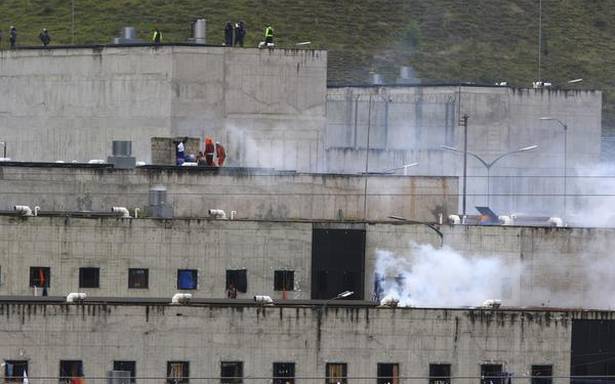The prison authority described fierce fighting between organised gangs that go by names such as Los Pipos, Los Lobos and Tigrones.
At least 75 inmates died February 23 and several were injured in riots blamed on gang rivalry at three jails in Ecuador’s overcrowded prison system, authorities said.
As security forces battled to regain control, distraught family members waited desperately for news outside the prison in Ecuador’s western port city of Guayaquil, where officials said 21 died.
Another 33 died at the prison in Cuenca in the south and eight in Latacunga in the centre of the South American country, according to Edmundo Moncayo, director of the government’s SNAI prisons management body.
“We want the death list given to us,” said Daniela Soria, 29, one of about 40 women outside the Guayaquil prison, many of them in tears. “We know that the problems are not over because everyone there has a phone and my husband doesn’t call me,” she told AFP.
A relative of an inmate grabs a fence outside the Centro de Privación de Libertad Zona 8 prison where riots broke out in Guayaquil, Ecuador, Feb. 23, 2021. | Photo Credit: AP
Earlier, she received a WhatsApp voice message from her husband, Ricardo, which she played back for AFP. “They are going to kill me, get me out of here!” he could be heard exclaiming, the last she heard from him.
Ecuador’s President Lenin Moreno, on Twitter, attributed the riots to “criminal organisations” engaged in “simultaneous acts of violence in several prisons.” The authorities, he said, “are acting to retake control.”
The military was deployed to help police quell the uprising.
The public defender’s office, an entity akin to an ombudsman set up to defend human rights, called the violence “an unprecedented massacre” and expressed its “concern over the lack of security in the country, which is reflected in the increase in crime and violence inside these prison facilities.”
‘Like a market’
The prosecuting authority said several inmates were left injured in fighting between “criminal gangs,” including two at Guayaquil in serious condition.
Several police were also injured, said Mr. Moncayo, but no deaths have been reported among security personnel.
Police commander Patricio Carrillo described the situation as “critical,” while Interior Minister Patricio Pazmino created a centralised command post to respond to what he said was “concerted action by criminal organisations to generate violence in penitentiary centres.”
The prison authority described fierce fighting between organised gangs that go by names such as Los Pipos, Los Lobos and Tigrones. They rely on drug trafficking and operate their criminal enterprises from prison.
Mr. Moncayo told reporters that on February 22, guards seized two firearms that were to be used to kill the leader of a group imprisoned in Guayaquil.
“Inside, it is like a market. There is everything: drugs, arms, even puppies. Everything is sold,” said Ms. Soria, the wife of prisoner Ricardo.
In order to reduce prisoner numbers amid the coronavirus epidemic, the government commuted the sentences of people convicted of minor offences, reducing overcrowding from 42% to 30%.
This still leaves Ecuador’s prison system, with a capacity to house 29,000 inmates in 60-odd facilities, with a prisoner population of 38,000.
There are 1,500 guards to oversee them.
Dearth of guards
The SNAI has said a dearth of personnel “hinders immediate response” to prisoner revolts.
Last year, inmate disputes left 51 dead, according to police figures.
A 90-day state of emergency in the country’s jails was ordered by Mr. Moreno last year to try to bring gang activity under control and reduce the violence.
But just in December, prison unrest left 11 prisoners dead and seven injured.
Tuesday’s riots coincided with a march of hundreds of indigenous people on Quito to demand a vote recount after a first round of presidential elections this month saw their candidate left out in the cold.
Source: Read Full Article


